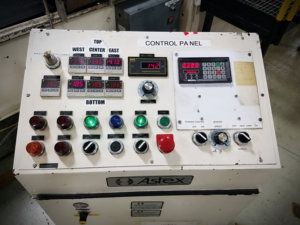Reverse Roll Coating: Is It Right For Your Purposes?

How Does A Roll Coater Work?
Before we jump into reverse roll coating, let’s touch upon how a roll coater works in a more basic sense. In its simplest form, a roll coater functions by transferring a coating from the surface of the roller to the surface of a part. We achieve this on an industrial scale, which means that a roll coating machine must operate consistently and efficiently. Every part should have the same amount of coating unless otherwise indicated or requested.
When we apply a coating through a roll coating machine, there’s a phenomenon known as film splitting. This means that part of the coating stays on the roller, while part of it applies to the surface, affecting the thickness of the coating and potentially its evenness as well. The severity of film splitting you’ll experience is dependent on a few different factors, including the coating material utilized, the surface material, and the roll coating machine and advanced coating technologies you choose.
What is Reverse Gravure?
Now, let’s delve into what exactly reverse gravure involves. First we must define direct gravure. This is a process that relies upon an engraved roll, which controls the amount of coating applied to the web. The “gravure” is the engraved roll. Usually, its surface is steel or ceramic, and it’s engraved with a cell pattern. We administer the coating through a pan (in which the roller is submerged) or enclosure, which presses the coating over the roller. A blade ensures that we remove any excess coating, and as the roll rotates it applies the coating, hitting the web at a nip point. You can locate the nip point between the engraved roll and a backing roll covered by rubber. Both rolls operate in the same direction and speed as the web, and they transfer the coating through the nip force between the rolls.
Reverse gravure is a form of reverse roll coating reliant upon that gravure. In this case, the gravure actually rotates in opposition to the web. The coating splits, which means that some transfers to the web, and some stays on the roll’s cells. The advantage of this approach is that it doesn’t require as much care towards the gravure roll as is necessary with direct gravure. Then you must wipe the surface clean after use with direct gravure, while with a reverse gravure that coating stays on the surface, where you don’t have to worry about it as much.
What Are The Benefits of Slot Die Coating Versus Reverse Roll Coating?
One process that we can compare against reverse roll coating is slot die coating. Slot die coating does offer a few differences from reverse roll coating, which we take into account before selecting a process. Essentially, slot die coating applies different formulas to a variety of substrates. Typically, these substrates will include glass, polymers, and metal. One of the main benefits of slot die coating is that it is very precise, metering the applicable fluids in a controlled manner, with the coating die moving in a manner relative to the substrate.
Other benefits of slot die coating include the ease with which the thickness of the wet-film relates to the flow rate of the solution, as well as the speed of the coated substrate relative to the head. With this in mind, slot die coating creates an extremely uniform application, and it’s quite efficient. Additionally, the coating mechanism requires no contact (therefore reducing the room for error) and it often achieves a higher line speed.
In comparison, reverse roll coating has benefits including a similar precision, though we achieve this before the machine applies the coating to the web. Each of the rolls utilized in the reverse roll coating process is independently driven, which increases its speed and efficiency. We supplement applicator and metering rolls by differential speed control as well.
How Can I Ensure Effective Coating?
As you can see above, there is more than one way to achieve a precise coating. However, you must ensure that you have good equipment, as well as experienced employees who can use it properly. This is why many business owners choose to work with third party manufacturing companies rather than managing coatings themselves.
There are many benefits to working with third party manufacturers. Conversion Technologies International, for example, can manage a variety of different coating processes. For example, some may offer professional laminating services, as well as more generalized coating services. Not only can these third party manufacturers offer you products—they may also be able to give you consultations and advice.
If you have any questions, connect with CTI directly. Please call us at 419-924-5566, or connect with us here. We’re ready and can help you navigate the complicated processes and choices that come with coating. It’s not quite as intimidating as it seems!
- << < Previous Post
- 1
- 2
- ...
- 57
- ...
- 240
- 241 Next Post > >>

